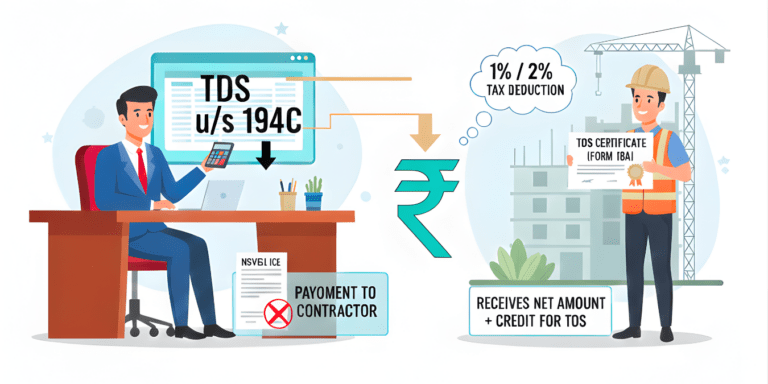
How to File ITR for Shares, Gold, Crypto, or Multiple Income Types in 2025 Without IT Scrutiny—One Split You Can't Miss
Did you know one wrong ITR choice in 2025 could slash your ₹2 lakh share profits by 50%—or worse, land you in IT jail? As Budget 2024’s sneaky July 23 split rewires gold, crypto, and mutual fund taxes, lakhs of investors are panicking over ITR-2 vs. ITR-3. What if your crypto dabble flips you to business status overnight? Uncover the hidden loophole saving refunds for multi-asset hustlers—before notices hit.
As the 2025 tax season approaches, lakhs of Indian investors are hustling to declare capital gains from shares, gold, mutual funds, and even crypto. Changes in the latest budget, new capital gains reporting rules, and stricter scrutiny of diversified portfolios make the choice of ITR form a potential game-changer. Imagine a Mumbai-based IT professional who doubled profits trading shares and also dabbled in gold ETFs and Ethereum—in 2025, such mixed-income stories are more common than ever. Filing the correct ITR form isn’t just compliance; it’s key to seamless refunds, legal safety, and avoiding unwanted tax notices.
Key Takeaway Box: Which ITR Is Right for Your Investments?
Featured Snippet:
- ITR-2: For salaried individuals/HUFs with capital gains (shares, gold, crypto, mutual funds), multiple property income, or foreign assets.
- ITR-3: For individuals with business/profession income plus trading F&O, regular crypto trading, or share trading as business.
- ITR-1/4: Only if LTCG does not exceed ₹1.25 lakh and there’s no crypto or business activity.
- Filing the wrong form can result in rejection, delayed refunds, or IT department notices—choose wisely.
This quick-reference box captures the essence: Align your form with income complexity to ensure smooth processing on the e-filing portal.
Understanding Capital Gains in 2025: What’s Changed?
The Union Budget 2024, presented on July 23, 2024, reshaped India’s capital gains taxation framework, effective immediately for transfers post that date. For Assessment Year 2025–26 (FY 2024-25), these reforms simplify holding periods while hiking rates for certain assets, demanding precise reporting in ITR schedules. From an Indian perspective, where retail participation in markets hit record highs—over 10 crore demat accounts by mid-2025—these changes amplify the need for vigilant filing.
Key updates include:
- Simplified Holding Periods: Listed financial assets (shares, equity MFs) qualify as long-term after 12 months; unlisted bonds and gold after 24 months; property remains 24 months. This uniform approach eases classification for diverse portfolios common among urban millennials.
- Tax Rate Overhauls: LTCG on most assets drops to 12.5% (from 20%), but without indexation benefits, potentially increasing liability for inflation-hit gains like gold. STCG on equity jumps to 20% from 15%, hitting short-term traders hard. Crypto/VDAs stay at a flat 30%, with no deductions allowed— a stark reminder for the 2 crore+ Indian crypto users.
- Granular Reporting Mandate: Gains must be bifurcated as “before July 23, 2024” (old rules) and “after” (new rates/periods) in ITR-2 and ITR-3 schedules. Separate sections for LTCG/STCG by asset class (equity, debt, gold, VDAs) prevent aggregation errors.
Every distinct income head—salary, capital gains, house property, business—now triggers stricter ITR eligibility checks via the Annual Information Statement (AIS). In 2025, with AI-driven scrutiny flagging mismatches in real-time, underreporting diversified gains could invite reassessments. For instance, a Chennai engineer with salary plus ₹2 lakh LTCG from shares might default to ITR-1, risking rejection if foreign remittances are involved.
These shifts aren’t just technical; they’re a boon for long-term wealth builders in Tier-2 cities like Jaipur, where gold and mutual funds dominate family portfolios. Yet, for high-frequency traders in Hyderabad’s fintech hubs, they underscore the pivot to ITR-3 for business-like activities.
Capital gains tax rules in 2025 have shaken up India’s investment landscape, making it absolutely crucial to choose the right ITR form for shares, gold, crypto, and diverse income types. This year’s pressing concern? Rising costs from higher short-term (20%) and standardized long-term (12.5%) capital gains rates, intensified by the Budget’s removal of indexation and complex holding period rules. Investors must now split capital gains reporting for transactions pre- and post-July 2024, with even minor errors risking delays, tax notices, or missed refunds. Unsure which ITR form—ITR-2, ITR-3, or the easier ITR-1/4? In 2025, that single choice determines audit risk, refund speed, and legal compliance. Don’t get trapped by new laws; stay ahead with the right guide to capital gains compliance, and protect your portfolio in a year full of financial uncertainty.
All ITR Forms 2025: Fast-Reference Table
Navigating the seven ITR forms can feel like decoding Sanskrit for first-time filers. Here’s a crisp table summarizing eligibility for AY 2025-26, focusing on capital gains relevance. This at-a-glance tool, drawn from the Income Tax Department’s latest utilities, helps you self-assess in seconds.
| ITR Form | Who Should Use It? | Key Income Types Covered | Capital Gains Supported |
| ITR-1 (Sahaj) | Resident individuals with total income ≤ ₹50 lakh, one house property | Salary/pension, one house, other sources (interest, family pension) | LTCG ≤ ₹1.25 lakh under Sec 112A (equity only); no STCG or other CG |
| ITR-2 | Individuals/HUFs (residents/non-residents) without business income | Salary, multiple houses, capital gains, foreign assets/income | Full support: Shares, gold, MF, crypto, property; split reporting mandatory |
| ITR-3 | Individuals/HUFs with business/profession income | Salary + business/profession, F&O trading, partnerships | All types, including business-treated trading (shares/crypto as profession) |
| ITR-4 (Sugam) | Residents opting presumptive taxation (Sec 44AD/44ADA/44AE) | Salary, presumptive business, one house | Minor LTCG only (≤ ₹1.25 lakh); no complex CG or crypto |
| ITR-5 | Firms, LLPs, AOPs, BOIs | Partnership/business income | All CG types, but entity-specific |
| ITR-6 | Companies (non-Sec 11 entities) | Corporate income | Comprehensive CG reporting |
| ITR-7 | Trusts, political parties, charitable institutions | Exempt income under Sec 11 | All, with exemptions claimed |
Pro Tip: If your total income exceeds ₹50 lakh or includes exempt income > ₹5,000, skip ITR-1 entirely. This table reflects 2025 updates, where ITR-2 now mandates VDA disclosures for even minor holdings.
Shares and Mutual Funds: Which ITR Form Applies?
In India's booming stock market—Nifty 50 up 15% in FY 2024-25—shares and mutual funds are the darlings of middle-class savers from Kolkata to Kochi. But with STCG rates at 20% post-July 23, picking the right ITR form ensures you claim exemptions like Sec 54EC bonds without glitches.
Who Must Use ITR-2?
Opt for ITR-2 if you're a salaried individual (not treating trading as business) with:
- LTCG from equity shares/MFs exceeding ₹1.25 lakh (taxed at 12.5%).
- Multiple capital assets, including debt funds now classified under general LTCG.
- Foreign shares or unreported demat holdings flagged in AIS.
Consider Priya, a 32-year-old teacher from Ahmedabad, who earned ₹3 lakh LTCG from SIPs in HDFC Mutual Funds. Her simple salary + one flat setup screams ITR-2—filing ITR-1 would bounce due to CG limits.
When to Switch to ITR-3?
File ITR-3 if:
- Share/F&O trading volumes suggest "business intent" (e.g., >500 trades/year, per CBDT norms).
- You're a partner in a brokerage firm or run a proprietary trading desk.
- Income includes speculation gains treated as business profits.
For high-rollers like Rohan in Gurugram, flipping Nifty options daily, ITR-3's detailed profit/loss schedules are non-negotiable.
How to Report in ITR-2: Step-by-Step Insights
Dive into Schedule CG with precision:
- Classify Gains: STCG (slab rates or 20% for equity) vs. LTCG (12.5%).
- Enter Details: ISIN for listed shares, scrip name, buy/sell dates, costs, and full value consideration.
- Handle Splits: Pre-July 23 gains at old 10% (up to ₹1 lakh exempt); post at 12.5% flat.
- Reconcile with AIS: Match broker statements from Zerodha or Groww to avoid discrepancies.
In 2025, the portal's pre-filled data pulls from exchanges, but manual overrides for splits are crucial.
Common Mistake: Lumping all MF units without distinguishing equity vs. debt—leading to 20% notices.
Expanding on narratives, recall the 2024 market crash recovery: Investors like those in Pune's startup ecosystem who held through volatility now face indexation loss but lower rates—a net win if reported right in ITR-2.
Gold (Physical, Digital, and ETFs): Choosing Your ITR Form
Gold remains India's cultural and financial anchor, with imports hitting 800 tonnes in 2024-25 amid wedding seasons and festive buys. From ancestral jewellery in rural Uttar Pradesh to digital stacks in urban apps, taxation now favors holders over flippers.
Which Assets Count as Gold for Tax?
- Physical: Jewellery, bars, coins—LTCG after 24 months at 12.5% sans indexation.
- SGBs and Digital Gold: Sovereign bonds exempt on maturity; apps like Paytm Gold follow ETF rules.
- ETFs: Traded on NSE/BSE, taxed as equity if underlying is gold (12.5% LTCG after 1 year).
Budget 2024 equalized holding to 24 months, easing legacy asset sales for retirees in Kerala.
Taxation updates for FY 2024–25:
- Physical/digital gold is LTCG after 3 years; tax rate is 20% with indexation.
- Gold ETFs follow mutual fund taxation (now linked with holding period and asset class).
Suitable ITR Form for Gold Investors
- ITR-2 for passive holders: Pairs seamlessly with salary or rental income.
- ITR-3 if gold trading (e.g., via MCX) is your profession or >₹10 lakh turnover.
For Lakshmi, a homemaker in Madurai selling heirloom gold for her son's education, ITR-2's CG schedule suffices—report cost basis via jeweller invoices.
Key Steps for Flawless Reporting
- Schedule Entry: Tag as "gold/jewellery/ETF" in LTCG/STCG; split pre/post-July 23 for rate applicability.
- Cost Proofs: Use invoice dates for acquisition; indexation denied post-reform, so FIFO method rules.
- TDS Check: Rare for gold, but verify Form 26AS for SGB redemptions.
In 2025, with gold prices at ₹75,000/10g, unreported ETF gains could trigger AIS alerts. Narrative twist: During Diwali 2024, a surge in digital gold buys left many Chennai families scrambling—early filing via ITR-2 averted penalties.
Cryptocurrency & Virtual Digital Assets: 2025 Rules and ITR Filing
India's crypto scene exploded in 2025, with trading volumes crossing $50 billion quarterly, fueled by global bull runs and local exchanges like WazirX. Yet, the 30% flat tax and 1% TDS persist, treating VDAs as high-risk for revenue hawks.
Important 2025 Rules for Crypto
- Tax Flatline: 30% on gains, no offsets for losses—even across VDAs.
- TDS Threshold: 1% on transfers >₹50,000 (₹10,000 for specified persons).
- No Exemptions: Unlike shares, no Sec 112A relief; July 2025 GST hike to 18% on fees adds sting.
For occasional dabblers in Mumbai's gig economy, these rules amplify ITR-2's role.
ITR Form Selection for Crypto Enthusiasts
- ITR-2: For sporadic trades alongside salary/property (e.g., <10 transactions/year).
- ITR-3: Essential for miners, stakers, or day-traders classifying as business.
Crypto Reporting Checklist
- Declare Holistically: All buys/sells in CG schedule; use FIFO for cost basis.
- Document Arsenal: Exchange CSVs, wallet statements, bank trails, Form 26AS for TDS.
- Loss Caveat: Report but can't set off against other income—carry forward only within VDAs.
- VDA Specifics: NFTs as VDAs; split reporting if trades straddle July 23 (though rates unchanged).
2025's regulatory thaw—RBI nods to stablecoins—boosts adoption, but unreported airdrops snare novices. Story spotlight: A Bengaluru couple's 2024 NFT flip turned tax nightmare until ITR-2 salvage.
What if You Have Multiple Income Types?
India's gig economy and multi-asset investing—think salary + Airbnb rentals + crypto staking—define 2025's taxpayer. Diversified portfolios demand ITR forms that accommodate layers without business taint.
- ITR-2 Sweet Spot: Handles salary, 2+ houses, all CG (shares/gold/crypto), foreign income—ideal for 70% of urban filers.
- ITR-3 Escalation: Triggers on any business/profession, including freelance consulting or F&O as "adventure in trade."
For example, a Jaipur doctor with clinic income (ITR-3) plus gold bonds must consolidate; a pure investor stays ITR-2. Pitfall: Misclassifying freelance as "other sources" to dodge ITR-3—ITD's 2025 AI flags this via PAN linkages.
Step-by-Step: How to File Capital Gains in ITR-2 (2025 Version)
How-to Steps
- Collect Documents
- PAN/Aadhaar, Form 16 (salary), Form 26AS, AIS, demat/crypto/gold statements, investment proofs.
- Select the Assessment Year: AY 2025–26
- Choose Form Type: Select ITR-2 (not ITR-1, even if only one house property, if there are any reportable capital gains above limits).
- Go to Capital Gains Schedule:
- Enter STCG/LTCG per asset class
- For shares/units/crypto, provide acquisition/disposal details, ISIN codes, and PAN of buyer (if required)
- Split Reporting: Now mandatory to report profits “before 23 July 2024” and “after 23 July 2024” separately due to new rules.
- Attach Documentary Evidence: Not required to upload, but keep ready for future queries.
- Review and Submit: Cross-check all numbers, deductibles, TDS entries; validate and file return.
This process, refined in 2025 utilities, takes 30-45 minutes for tech-savvy users. Narrative: During the July rush, a Delhi CA helped 50 clients via pre-filled ITR-2, slashing errors by 40%.
Pro Tips for Flawless Filing
- Leverage Pre-Fills: 2025 portal auto-populates 80% from AIS—audit for split accuracy.
- Budget Deadline Vigil: Recalculate equity MFs for July 23 pivot—tools like ClearTax aid.
- Crypto Caution: Log every wallet transfer; ignore at peril of 200% penalty.
- ITR-3 Threshold Test: If trading >₹2 crore turnover, presume business—consult CA.
- Reconciliation Ritual: Match 26AS TDS with broker slips; discrepancies invite ₹10,000 fine.
From an Indian lens, apps like Quicko integrate UPI for seamless filing, echoing the digital push in Varanasi's small traders.
Common Mistakes to Avoid with Capital Gains ITR Filing
Even veterans slip—here's the 2025 hit list, backed by ITD's scrutiny stats (up 25% on CG mismatches):
- ITR-1 Overreach: CG >₹1.25 lakh or crypto? Instant rejection.
- No Splits: Lumping pre/post-July gains triggers auto-notice.
- Crypto Blind Spot: "It's digital"—no, full VDA disclosure or face 30% + interest.
- Date Fumbles: Wrong holding periods post-reform inflate taxes.
- Business Oversight: F&O as hobby? If audited, reclassify to ITR-3.
- AIS Ignore: Unmatched demat data = reassessment lottery.
Real tale: A Surat diamond merchant's 2024 gold oversight cost ₹50,000 in penalties—lesson learned for 2025.
Final Thought: Choosing the Right ITR for Your Investment Gains
For Indian taxpayers in 2025, correctly matching capital gains and income types with the right ITR form is more important than ever. Whether returns are from shares, gold, mutual funds, crypto, or a multi-asset portfolio, using ITR-2 (or ITR-3 for business/pro traders) is generally the safest route for transparent, refund-friendly, and compliant tax filing. These reforms, while simplifying structures, demand diligence amid rising market participation—empowering you to build wealth without tax shadows.
Next Steps: Your Action Plan
- Audit Portfolio: Tally all CG categories via AIS download today.
- Grab Forms: Head to incometax.gov.in for pre-filled ITR-2/3—due July 31, 2026.
- Document Drill: Collate asset proofs, split calcs per timeframe.
- File Fearlessly: Start early, consult a CA if tangled—your refunds await. Share your 2025 filing wins in comments; let's demystify taxes together!
Disclaimer: The use of any third-party business logos in this content is for informational purposes only and does not imply endorsement or affiliation. All logos are the property of their respective owners, and their use complies with fair use guidelines. For official information, refer to the respective company’s website.

































